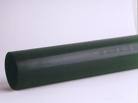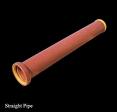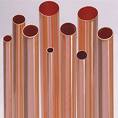Acrylonitrile Butadiene Styrene (ABS)
 – A black composite plastic used to making plumbing pipes and fittings. It is considered to be inferior to PUC.
– A black composite plastic used to making plumbing pipes and fittings. It is considered to be inferior to PUC.
 The first cast iron pipe manufactured in the US and was produced in a foundry in Weymouth, New Jersey in the early 1800’s. The city of Philadelphia began installing cast iron pipes in its water distribution system circa 1804-1810. In fact, Philadelphia was the first American city to use cast iron pipe. Due to its greater longevity and the fact that water pressure could be maintained with, it was higher than wood pipe could handle.
The first cast iron pipe manufactured in the US and was produced in a foundry in Weymouth, New Jersey in the early 1800’s. The city of Philadelphia began installing cast iron pipes in its water distribution system circa 1804-1810. In fact, Philadelphia was the first American city to use cast iron pipe. Due to its greater longevity and the fact that water pressure could be maintained with, it was higher than wood pipe could handle.Sewerhistory.orgCast iron today doesn’t usually get past 4-5 ft. of the foundation. It was mostly used for inside plumbing in CT. It was replaced by newer materials and it is still used inside higher end buildings where the owner is looking for quieter plumbing.
 is one of the most ancient pipe materials with the earliest example from Babylonia (4000 BC). Used in America since the 1800’s, Clay is strong and long lasting. I work on clay pipes that are 100 years old and look brand new. However, roots can grow in through the joints because they did not use gaskets back then. Clay pipes come inmany lengths and diameters. Clay is also used to make footing drains.
is one of the most ancient pipe materials with the earliest example from Babylonia (4000 BC). Used in America since the 1800’s, Clay is strong and long lasting. I work on clay pipes that are 100 years old and look brand new. However, roots can grow in through the joints because they did not use gaskets back then. Clay pipes come inmany lengths and diameters. Clay is also used to make footing drains. – Used mostly for storm sewers manholes, septic tanks, dry wells and catch basins used in the US since the 1900’s.
– Used mostly for storm sewers manholes, septic tanks, dry wells and catch basins used in the US since the 1900’s.
 came into use in the late 19th century. It comes in (3) grades. It is strong, clean, smooth, and long lasting. Copper is a real good material, but it is costly compared to plastic. It is also subject to theft by vandals who sell it by the pound to scrap yards. I have worked for many people that have rehabbed their homes that have either bought a house with the copper missing or lost it after the start of construction. Personally I like copper because the cleanouts come off easy as it resists corrosion.
came into use in the late 19th century. It comes in (3) grades. It is strong, clean, smooth, and long lasting. Copper is a real good material, but it is costly compared to plastic. It is also subject to theft by vandals who sell it by the pound to scrap yards. I have worked for many people that have rehabbed their homes that have either bought a house with the copper missing or lost it after the start of construction. Personally I like copper because the cleanouts come off easy as it resists corrosion..jpg) – A steel pipe that rust from the inside out and is notorious for clogging and leaking. It was and is mostly used for branch lines in its life as a drain pipe in conjunction with cast iron stacks. It is notorious for clogging because it rust from the inside out and catches all the soap, grease, hair and waste that comes by. Galvanized also leaks due to its rusting problem people usually replace it with plastic.
– A steel pipe that rust from the inside out and is notorious for clogging and leaking. It was and is mostly used for branch lines in its life as a drain pipe in conjunction with cast iron stacks. It is notorious for clogging because it rust from the inside out and catches all the soap, grease, hair and waste that comes by. Galvanized also leaks due to its rusting problem people usually replace it with plastic.
sizes ranging from 3’ to 8’ inches for sewer and drain applications.
Orangeburg pipe is comprised of cellulose fibers impregnated with hot coal tar pitch. The joints are gasket less. The pipe softens and deforms with age allowing infiltration and root intrusion. Two varieties exist: one with solid walls and one with laminated walls. This pipe material was widely used in house laterals for over 70 yrs. Until PVC took over.
Sewerhistory.org OB was used for sanitary and storm. It’s found in newer neighborhoods in CT (1940’s -1970’s). One town that comes to mind is New Britain, CT. If you live in one of these OB areas, you or a neighbor has probably had trouble in the past. In my opinion, roots aren’t the major worry with OB but it’s the pipe collapsing due to the ground settling or heavy equipment having traversed the areas of your property where pipes lay. OB has to be the worst pipe I encounter on a regular basis (its junk.)
.jpg) used to make various plumbing parts. It is superior to ABS. PUC was discovered in 1835. It was first manufactured in 1935 in Germany and then installed in Germany the following year. It started being used in 1952 in the US. PVC comes in several diameters up to 48’ inches. It lasts long and is the primary material used in new construction and it is a composite plastic and is deemed stronger than its cousin ABS.
used to make various plumbing parts. It is superior to ABS. PUC was discovered in 1835. It was first manufactured in 1935 in Germany and then installed in Germany the following year. It started being used in 1952 in the US. PVC comes in several diameters up to 48’ inches. It lasts long and is the primary material used in new construction and it is a composite plastic and is deemed stronger than its cousin ABS.
 been able to see it before and it looks like a wooden barrel that was stretched into a pipe. To witness this was really cool! Apparently, when you want to make a wooden sewer you use wood that doesn’t rot easily like redwood, elm, or hemlock.
been able to see it before and it looks like a wooden barrel that was stretched into a pipe. To witness this was really cool! Apparently, when you want to make a wooden sewer you use wood that doesn’t rot easily like redwood, elm, or hemlock.